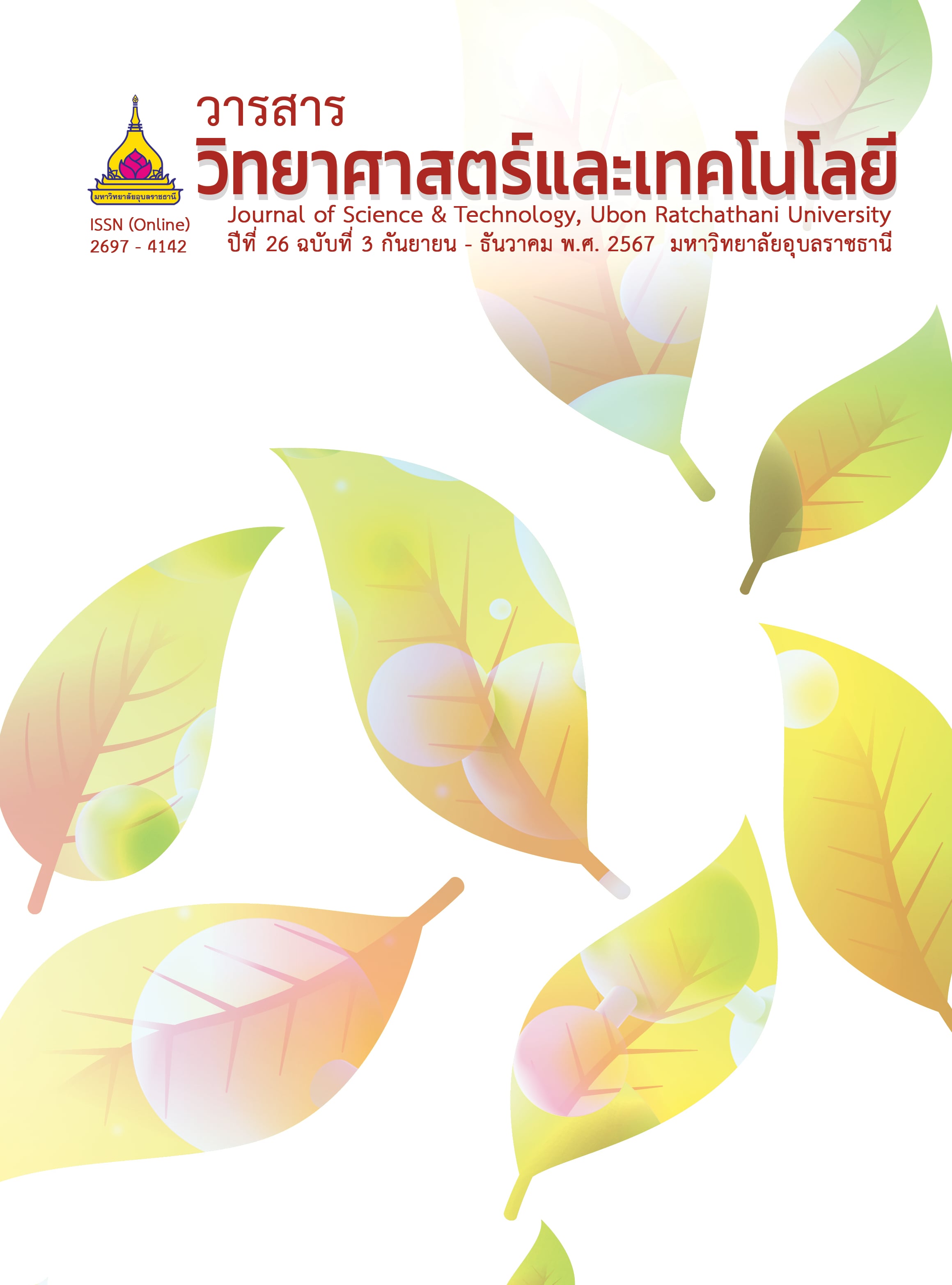ผลของความเข้มข้นของซัลเฟตในน้ำเสียสังเคราะห์ต่อประสิทธิภาพของออสโมซิสย้อนกลับ ในการบำบัดน้ำเสีย
Main Article Content
บทคัดย่อ
งานวิจัยนี้มีวัตถุประสงค์เพื่อศึกษาผลของความเข้มข้นของซัลเฟตในน้ำเสียสังเคราะห์ต่อประสิทธิภาพในการบำบัดน้ำเสียของออสโมซิสย้อนกลับที่ใช้เมมเบรน TW30-1812-75GPD การศึกษานี้ใช้น้ำเสียสังเคราะห์ที่มีความเข้มข้นของซัลเฟตเท่ากับ 500, 700, 1,000, 1,300, 1,500, 1,800 และ 2,000 มิลลิกรัมต่อลิตร โดยความเข้มข้นของซัลเฟตที่ใช้มีค่าใกล้เคียงกับความเข้มข้นของซัลเฟตที่พบในน้ำเสียจริงที่เกิดจากกระบวนการผลิตยางพารา จากการศึกษาอัตราการไหลของน้ำผ่านการกรอง พบว่าเมื่อความเข้มข้นของซัลเฟตเพิ่มขึ้น ซึ่งทำให้เมมเบรนเกิดการอุดตันมากขึ้น ส่งผลให้อัตราการไหลของน้ำที่ผ่านการกรองมีค่าลดลง โดยอัตราการไหลของน้ำที่ผ่านการกรองของน้ำเสียสังเคราะห์ที่มีความเข้มข้นของซัลเฟตเท่ากับ 500, 700, 1,000, 1,300, 1,500, 1,800 และ 2,000 มิลลิกรัมต่อลิตร มีการลดลงคิดเป็นร้อยละ 36.24, 41.41, 46.62, 54.03, 60.62, 62.35 และ 67.46 ตามลำดับ เมื่อเทียบกับอัตราการไหลของน้ำที่ผ่านการกรองของน้ำที่ไม่มีซัลเฟต อย่างไรก็ตาม จากการศึกษากลับพบว่าความเข้มข้นของซัลเฟตในน้ำเสียสังเคราะห์ไม่มีผลต่อประสิทธิภาพในการกำจัดซัลเฟต ประสิทธิภาพในการกำจัดของแข็งละลายน้ำทั้งหมด ประสิทธิภาพในการลดค่าการนำไฟฟ้า และค่าพีเอชของน้ำที่ได้หลังจากการกรอง
Article Details

อนุญาตภายใต้เงื่อนไข Creative Commons Attribution-NonCommercial-NoDerivatives 4.0 International License.
บทความที่ได้รับการตีพิมพ์เป็นลิขสิทธิ์ของ วารสารวิทยาศาสตร์และเทคโนโลยี มหาวิทยาลัยอุบลราชธานี
ข้อความที่ปรากฏในบทความแต่ละเรื่องในวารสารวิชาการเล่มนี้เป็นความคิดเห็นส่วนตัวของผู้เขียนแต่ละท่านไม่เกี่ยวข้องกับมหาวิทยาลัยอุบลราชธานี และคณาจารย์ท่านอื่นๆในมหาวิทยาลัยฯ แต่อย่างใด ความรับผิดชอบองค์ประกอบทั้งหมดของบทความแต่ละเรื่องเป็นของผู้เขียนแต่ละท่าน หากมีความผิดพลาดใดๆ ผู้เขียนแต่ละท่านจะรับผิดชอบบทความของตนเองแต่ผู้เดียว
เอกสารอ้างอิง
Rubber Authority of Thailand. 2018. Technical Data of Rubber in Year 2018. https://www. raot.co.th/download/technical_data_of_rubber_61.pdf. Accessed 5 July 2023. (in Thai)
Mohammadi, M. and et al. 2010. Treatment of wastewater from rubber industry in Malaysia. African Journal of Biotechnology. 9(38): 6233-6243.
Kanathip, P. and Sompong, O. 2017. Biological hydrogen sulfide and sulfate removal from rubber smoked sheet wastewater for enhanced biogas production. Energy Procedia. 138: 569-574.
Raketh, M. and et al. 2021. Sulfate removal using rubber wood ash to enhance biogas production from sulfate-rich wastewater generated from a concentrated latex factory. Biochemical Engineering Journal. 173: 108084.
Weerachart, I. 2008. Treatment of Sulfate in Wastewater from Concentrated Latex Factory using Fly Ash from Waste Incinerators in Phuket. M.Sc. Thesis, Prince of Songkla University. (in Thai)
Wanseng, W., Danteravanich, S. and Chevakidagarn, P. 2017. Investigation of excess sludge generated from activated sludge treatment plant of concentrated latex factories: An investigative case study in Southern Thailand. Environment and Natural Resources Journal. 15(2): 51-61.
Kanokwan, S. and Piyarat, B. 2012. Wastewater treatment of concentrated latex and standard Thai rubber production by commercial photosynthetic bacteria. In: Proceedings of the 50th Kasetsart University Annual Conference, 31 January - 2 February 2012. Bangkok, Thailand. (in Thai)
Rattana, J. 2000. Separation Process with Synthetic Membranes. Bangkok: Thai Seng Printing House Press. (in Thai)
Xiang, Z. and et al. 2022. Recycling of aged RO membrane as NF/UF membranes: Biosafety evaluation and aging process. Desalination. 538: 115845.
Awittha, R. 2010. Removal of Sulfate by Reverse Osmosis with a Spiral Membrane. M.Sc. Thesis, Chiang Mai University. (in Thai)
Kilduff, J.E., Mattaraj, S. and Belfort, G. Georges, B. 2004. Flux decline during nanofiltration of naturally-occurring dissolved organic matter: Effects of osmotic pressure, membrane permeability, and cake formation. Journal of Membrane Science. 239: 39-53.
Cho, J., Amy, G. and Pellegrino, J. 1999. Membrane filtration of natural organic matter: initial comparison of rejection and flux decline characteristics with ultrafiltration and nanofiltration membranes. Water Research. 339(11): 2517-2526.
Cho, J., Amy, G. and Pellegrino, J. 2000. Membrane filtration of natural organic matter: Comparison of flux decline, NOM rejection, and foulants during filtration with three UF membranes. Desalination. 127: 283-298.
Kritsana, C. 2004. Principles of General Chemistry. volume 1. Bangkok: Chulalongkorn University Press. (in Thai)
Khanthong, S. 2004. Membrane Separation Technology. Bangkok: Chulalongkorn University Press. (in Thai)
Kim, S.J. and et al. 2015. Foulant characterization and distribution in spiral wound reverse osmosis membranes from different pressure vessels. Desalination. 370: 44-52.
Kucera, J. 2011. Reverse Osmosis: Design, Processes, and Applications for Engineers. Hoboken: John Wiley & Sons, Inc.
Rusydi, A.F. 2017. Correlation between conductivity and total dissolved solid in various type of water: A review. IOP Conference Series: Earth and Environmental Science. 118(1): 012019.
Ali, N.S., Mo, K. and Kim, M. 2012. A case study on the relationship between conductivity and dissolved solids to evaluate the potential for reuse of reclaimed industrial wastewater. KSCE Journal of Civil Engineering. 16: 708-713.


